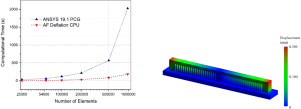Computer-Aided Design ( IF 3.0 ) Pub Date : 2020-03-04 , DOI: 10.1016/j.cad.2020.102829 Bhagyashree C. Prabhune , Krishnan Suresh

|
Process planning for additive manufacturing (AM) today relies heavily on multi-physics, multi-scale simulation. The focus of this paper is on one aspect of AM simulation, namely, part-level elasto-plastic simulation for residual stress and distortion predictions. This is one of the crucial steps in AM process optimization, but is computationally expensive, often requiring the use of large computer clusters.
The primary bottleneck in elasto-plastic simulation is the repeated solution of large linear systems of equations. While there is a wide range of linear solvers, most cannot exploit the unique structured nature of the mesh underlying AM. Here, we revisit a specific matrix-free solver, namely rigid-body deflated solver that has been very successful for solving large linear-elastic problems in such scenarios. The salient feature of this solver is that the stiffness matrix is never assembled, thereby reducing the memory requirements significantly, leading to large computational gains.
The objective of this paper is to extend the above solver to elasto-plasticity by efficiently updating the element tangent stiffness matrices, and the corresponding deflation matrix. The performance of the proposed method is evaluated on a benchmark problem using multi-core CPU and GPU architectures, and compared against ANSYS. Then, part-level residual stresses and distortion are predicted using the proposed solver. The present work is restricted to associative plasticity with von-Mises yield criteria, but can be extended to other plasticity models.
中文翻译:

快速无矩阵弹塑性求解器,用于预测增材制造中的残余应力
如今,增材制造(AM)的过程计划在很大程度上依赖于多物理场,多尺度仿真。本文的重点是AM仿真的一个方面,即用于残余应力和变形预测的部分级弹塑性仿真。这是AM过程优化中的关键步骤之一,但计算量很大,通常需要使用大型计算机集群。
弹塑性仿真的主要瓶颈是大型线性方程组的反复求解。尽管线性求解器种类繁多,但大多数无法利用AM底层网格物体的独特结构性质。在这里,我们将重新讨论一种特定的无矩阵求解器,即刚体放气求解器,该求解器在解决此类情况下的大型线性弹性问题方面非常成功。该求解器的显着特征是,从未组装过刚度矩阵,从而显着降低了内存需求,从而带来了较大的计算量。
本文的目的是通过有效地更新单元切线刚度矩阵和相应的放气矩阵,将上述求解器扩展到弹塑性。在使用多核CPU和GPU架构的基准问题上评估了所提出方法的性能,并与ANSYS进行了比较。然后,使用提出的求解器预测零件级的残余应力和变形。目前的工作仅限于具有von-Mises屈服准则的关联可塑性,但可以扩展到其他可塑性模型。











































 京公网安备 11010802027423号
京公网安备 11010802027423号